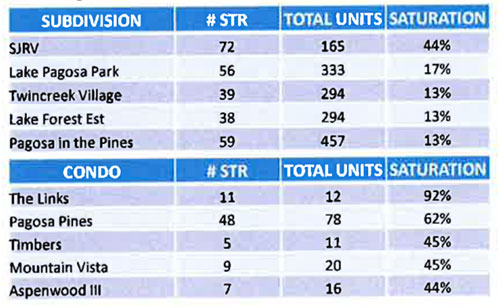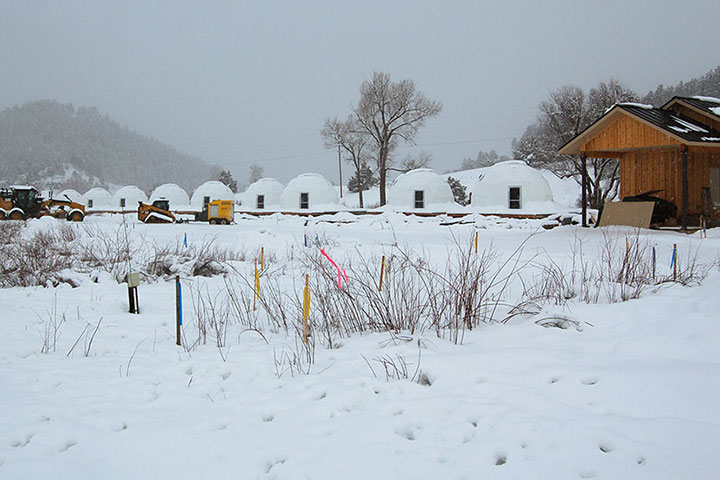At their January 3 regular meeting, the Archuleta Board of County Commissioners approved an extension to the County’s more lenient ‘Temporary Use Permit’ policy regarding recreational vehicles (RVs). The policy allows individuals and families to live in an RV for up to 180 days, after paying $50 for a County permit… and they can renew the permit for an additional 180 days.
Essentially, the BOCC policy allows people to live year-round in a RV, while also acknowledging that, according to Colorado statutes, RVs are intended for “temporary living and sleeping accommodations”.
In presenting the proposed extension, Community Development Director Pam Flowers explained that, due to the current housing crisis, a fair number of full-time residents — including local workers — are living year-round in RVs. Without the 180-day permit policy, the County Planning Department would presumably be kicking people out of their ‘homes’ in an economic environment where long-term rentals are difficult to find and even more difficult to afford.
Reportedly, the enforcement of the existing RV policy has been problematic due to limited County enforcement staff.
The housing crisis has contributed to a shortage of employees at the County, and elsewhere. So we allow people to live year-round in RVs. The County government hopes that’s just a temporary solution.
During a meeting last Wednesday at the Library, a group of community activists discussed the question of density caps that might limit the number of Short Term Rentals (STRs) in certain neighborhoods. The Town of Pagosa Springs has already established limiting regulations within the town boundaries, but the BOCC has yet to establish any limits, despite the fact that the vast majority of STRs — and the vast majority of homes — are located in the unincorporated county.
Back in 2021, the County Planning Department recommended a cap of 5% in all subdivisions, with no caps for rural homes located outside of subdivisions. Most of the homes in Archuleta County are located within subdivisions.
Is 5% the right percentage? We already have county subdivisions where the percentage of STRs far exceed 5%. Two examples are San Juan River Village, where about 44% of the homes have been converted into STRs, and Lake Pagosa Park, where 17% of the homes are now STRs. We also have condos where a large percentage of units are currently functioning as STRs. Here’s a chart provided by the County Planning Department last summer:

Pam Flowers has made the suggestion that density caps within residential neighborhoods would encourage STR investors to locate in the more rural areas of the county, where the negative social impacts would presumably be less noticeable. She has also suggested that caps should be more strict for condos, to help keep those dwelling units available to our workforce… given that workers, struggling to find housing, would likely find condos more affordable than single-family homes.
Our community STR study group will hold a subcommittee meeting this Wednesday at 4:30pm at the Sisson Library, small meeting room, to continue our discussion about density caps. The meeting is public and interested citizens are welcome to attend. (Call me for more information: 970-903-2673.)
At our study group meeting last week, a wide range of opinions were shared, on the subject of density caps.
During the discussion, downtown resident Glenn Walsh offered the following comments about how STRs affect the character of neighborhoods:
“I don’t really have any real fixed opinion about caps. In my own experience, I haven’t noticed that the families staying in STRs are more badly behaved [than full-time residents]. We’re human beings, and we can be annoying; I think I’m annoying to most people…
“But other people have found STRs to be a problem, and I respect that…
“My approach is… I buy that STRs are an important part of the economy. It’s a new model of the motel. We have STR-type motels going up downtown, and I expect that’s probably a model that we’re going to see more of…”
I assume Mr. Walsh is talking about a collection of cabins currently under construction near the downtown ‘geothermal’ growing domes along the river…

…and another development of ‘dome’ cabins under construction at the east end of town…

Both of these lodging developments reflect the current tourism trend… visitors looking for individual, separate dwelling units… rather than a typical ‘room in a motel’.
Mr. Walsh continued:
“I also think STRs receive an incredible tax subsidy that other businesses don’t receive. And I buy their argument, that I think is really well documented in the recent Root Policy study, that the STRs bring a lot of people to town… and to the county, even more than the town. A lot of those houses used to be less-than-fully occupied.
“And the tourists are out there, spending money and creating jobs.
“But the other kicker is, the jobs they create are at the 60%-70% AMI (Area Median Income) threshold, which creates a huge problem.
“So I’m not… if the direction the county voters and the government wants to go, is to cap the number of STRs, that’s fine. But my own approach is that it’s a pretty dynamic and important industry, and I can see the appeal to people — buying houses here, who might want to live here eventually, or have a second home… who want to have their cake and eat it, too. ‘Hey, I can have a home here and use it a few weeks of the year, and the rest of the time rent it out as an STR…’
“So my approach is more: equitable taxing, and dedicating those taxes to the actual impacts. To roads and affordable housing.
“If you buy the argument of the STR proponents, especially in the county, these homes were, for the most part, previously used maybe four or five times a year, and now they are being filled with two people per bedroom plus two…”
Mr. Walsh is here referring to the permitted use of an STR, under the County’s Land Use Regulations. Two persons per bedroom, plus two. So, for example, a three-bedroom STR is allowed an occupancy of eight people. Not many Archuleta County families include eight people. Most include two, or three.
He continued:
“Instead of one or two cars that visit five times a year, you have four, five, or six cars, 45 times a year. So I’d rather see it as a very dynamic industry, that can afford to pay for its impacts.
“So my concerns are not around ‘caps’. But I respect other people who believe caps are important…”
If the County government is going to assign caps in neighborhoods, what would be reasonable?
